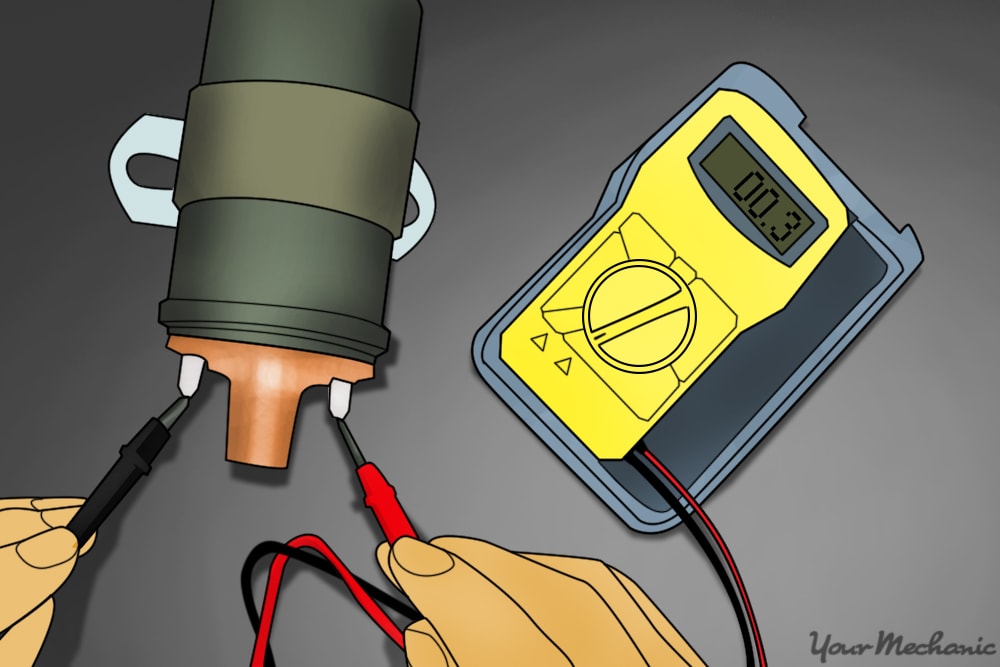
Ignition coils take energy from the battery usually 12 volts and convert it to a high enough voltage 50000 volts or more to create a spark. To test the coils secondary winding attach the test probes to the outer 12-volt pole on the coil and the center pole where the main wire goes to the distributor.

It doesnt matter which lead is on which terminal because you are reading resistance not amps or volts.
How to test the ignition coil. How to Tell if an Ignition Coil is Bad. Youll want to start by checking for signs of bad ignition coils and then follow up that diagnosis by testing the coils with a multimeter. Ignition coils take energy from the battery usually 12 volts and convert it to a high enough voltage 50000 volts or more to create a spark.
To test the ignition coil connect the ohmmeters two test leads to the coils primary terminals and -. Most coils should read between 04 and 2 ohms. Zero resistance would indicate a shorted coil while a high resistance reading would indicate an open coil.
Performing an Ignition Coil Resistance Test Bench Test 1. Remove the ignition coil from the vehicle. The test above isnt the only way to determine whether the ignition coil.
Find the resistance specifications for your ignition coil. Every vehicles ignition coil has its own unique. You can also test an ignition coil with a spark tester.
The tool is installed inline with the ignition coil to determine if the coil is producing a spark. If all of the ignition coils arent delivering spark the issue is likely with the control side primary side of the ignition system rather than a single ignition coil. An absence of spark from just ONE ignition coil points to a bad coil.
To test the operation of both the ignition coil and the spark plug connect the tester between the spark plug boot and the spark plug. Then start the engine and watch the tester window. A spark plug misfire will immediately be evident in the tester window.
This video describes a simple and easy one man procedure to test if your coil is firing properly. There are two ways to test the ignition coil of your vehicle. The spark plug test and the bench test.
While the spark plug test is effective the bench test is more thorough. A reading over the specification signals that the ignition coil is open which would also indicate a need to replace the coil. Test the secondary circuit of the ignition coil.
To test the coils secondary winding attach the test probes to the outer 12-volt pole on the coil and the center pole where the main wire goes to the distributor. The 12-volt pole is the spot where the power comes into your coil. It will be marked with a sign or it might only be indicated by a number.
A reading over the specification signals that the ignition coil is open which would also indicate a need to replace the coil. Test the secondary circuit of the ignition coil. Connect your multimeter to the positive terminal or pin of your coil and to the high output terminal that goes to the spark plug.
Move one of the test leads from the side terminal to the high-tension terminal in the center of the coil. It doesnt matter which lead is on which terminal because you are reading resistance not amps or volts. Note the reading from the ohmmeter–you are looking for a reading ranging from 7500 to 11000.
Now to check this resistance attach the ohmmeter to the outside poles of the primary winding. For the secondary winding attach one end to either of the poles and the other end to a central high tension terminal. Then check the values.
As you can see this test is more thorough as it gives the exact state of the ignition coil. Involves testing your secondary circuit of the ignition coil. This step involves connecting the positive terminal of your ignition coil to your digital multimeter and then to the high output terminal which runs to the spark plug.
The majority of the ignition coils usually have a secondary resistance of about 6000 to 10000 ohms. Move the test lead from the negative post on the coil to the center terminal where the large wire was removed. Keep the other lead on the positive post of the coil.
Note the resistance reading on the ohmmeter. Your coil should have a reading of between 6000 and 15000 ohms for your Ford. Lay the ignition coil on a work surface.
Set the dial on an ohm meter or multi-meter to 20k ohms. Insert the positive lead on the ohm meter into the end socket or the metal hoop on the spark plug wire. Put the negative lead of the tester onto the metal armature portion of the ignition coil.
83k members in the AutomotiveLearning community. Automotive learning is a place for new and seasoned gearheads to come together to share stories.